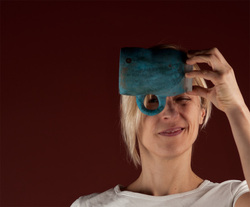from clay to art

The designing process of my art works start with a piece of clay. Most of the time I work intuitively. I start with a classic form like a sphere or a cylinder and transform it step by step.
When I work with porcelain, I like to make a plaster-prototype and a mold for casting. Plaster is a fine material, allowing to work intuitively like a sculpturer, taking away what is "hiding" the sculpture instead of adding some clay like in the process of modelling.
The larger a work growes, the longer it takes to dry. Some of my pieces dried for months. During the drying process the designing continues. Sometimes I change the surface by etching,stretching parts, painting, washing away clay,.. When the work is bone dry it goes to the kiln.
When I work with porcelain, I like to make a plaster-prototype and a mold for casting. Plaster is a fine material, allowing to work intuitively like a sculpturer, taking away what is "hiding" the sculpture instead of adding some clay like in the process of modelling.
The larger a work growes, the longer it takes to dry. Some of my pieces dried for months. During the drying process the designing continues. Sometimes I change the surface by etching,stretching parts, painting, washing away clay,.. When the work is bone dry it goes to the kiln.
the firings

The first firing is at a temperature of 960°C. It stabilizes the work and releases the chemical bound water. The work takes on the charakter of ceramics.
After working on the surface again with glazes, acids, natural materials (eg. for saggar firings) and sand-paper it goes to one of my kilns.
I have a raku-kiln that fires at about 1000°C, an electric klin (1230°C) and a gas-kiln (1300°C). And I have an old rain barrel to do so called pit firings.
Raku and Pitfirings are two ancient forms of firings. Both work with the designing-force of fire. The part of the artist is to enhance opportunities. This I do with adding acids, salts, organic materials to the work. The fire does the rest. There is no control over the process. The result is always a surprise. Because the fire is not evenly hot, sometime the work breaks. It is a high risk firing method but it rewards you with the finest patterns and colours.
When the work is finished, I polish it with beewax to obtain a smooth satin finish.
After working on the surface again with glazes, acids, natural materials (eg. for saggar firings) and sand-paper it goes to one of my kilns.
I have a raku-kiln that fires at about 1000°C, an electric klin (1230°C) and a gas-kiln (1300°C). And I have an old rain barrel to do so called pit firings.
Raku and Pitfirings are two ancient forms of firings. Both work with the designing-force of fire. The part of the artist is to enhance opportunities. This I do with adding acids, salts, organic materials to the work. The fire does the rest. There is no control over the process. The result is always a surprise. Because the fire is not evenly hot, sometime the work breaks. It is a high risk firing method but it rewards you with the finest patterns and colours.
When the work is finished, I polish it with beewax to obtain a smooth satin finish.
